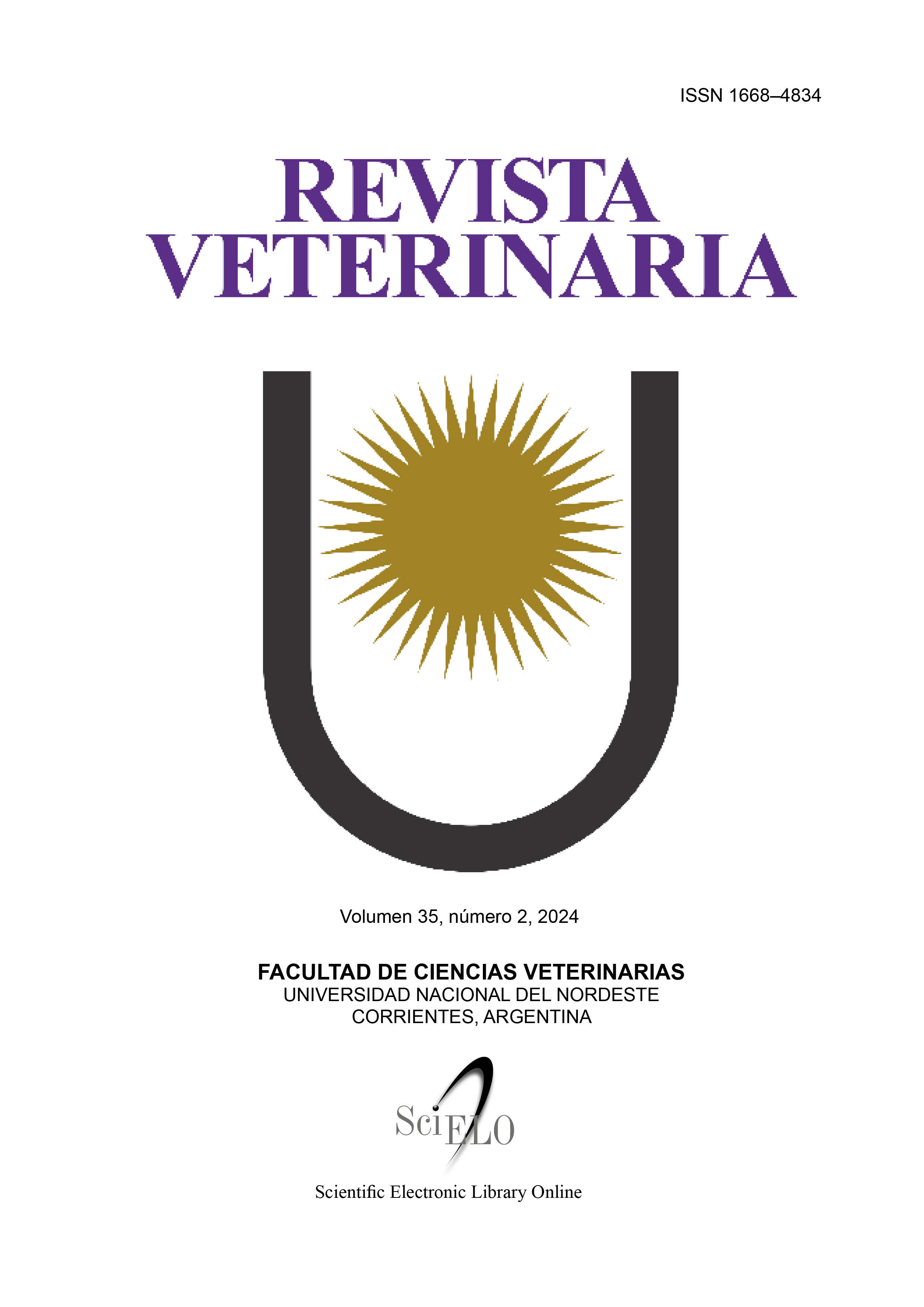Serum proteinogram evaluation in dogs with monocytic ehrlichiosis in northeastern Argentina
DOI:
https://doi.org/10.30972/vet.3527867Keywords:
Electrophoresis, Acute phase proteins, GammapathyAbstract
Canine monocytic ehrlichiosis (CME) is a tick-borne infectious disease that triggers an acute inflammatory response in dogs. The aim of this study was to evaluate serum protein profile alterations in dogs with CME, to identify potential biomarkers for diagnosis and disease monitoring. Serum samples from eight dogs with a confirmed CME diagnosis through polymerase chain reaction was analyzed. The results of the proteinogram revealed significant alterations in protein fractions. Hypoalbuminemia was observed in seven cases, hypogammaglobulinemia in six, hyperalpha-2 globulinemia in seven, and hyperbeta-globulinemia in two cases. These findings suggest a decrease in hepatic protein synthesis, an altered immune response, and an active inflammatory process. Polyclonal hypergammaglobulinemia, identified in two cases, indicate chronic immune system activation. Unlike hypogammaglobulinemia, which was present in six patients, this condition is not a common manifestation of the disease and could be linked to the pathogenic processes of CME, potentiallyincreasing the susceptibility to secondary infections. In conclusion, serum protein profile is a useful tool for evaluating the inflammatory response in CME cases. The observed alterations in protein fractions can serve as biomarkers for disease diagnosis and monitoring. This study provides relevant information for future research aimed at better understanding the disease pathogenesis and developing new diagnostic tools.
Downloads
References
Aguiar DM, Ziliani TF, Zhang X, Melo AL, Braga IA, Witter R. Ehrlichia genotype strain distinguished by the TRP36 gene naturally infects cattle in Brazil and causes clinical manifestations associated with ehrlichiosis. Ticks Tick Borne Dis. 2014; 1: 1-8.
Asawakarn S, Dhitavat S, Taweethavonsawat P. Evaluation of the hematological and serum protein profiles of blood parasite coinfection in naturally infected dogs. Thai J Vet Med. 2021; 51: 723-728.
Breitschwerdt EB, Hegarty BC, Qurollo BA, Saito TB, Maggi RG, Blanton LS, Bouyer D. Intravascular persistence of Anaplasma platys, Ehrlichia chaffeensis, and Ehrlichia ewingii DNA in the blood of a dog and two family members. Parasit Vectors. 2014; 7: 298-304.
Ceron JJ, Eckersall PD, Martynez-Subiela S. Acute phase proteins in dogs and cats: current knowledge and future perspectives. Vet Clin Pathol. 2005; 34: 85-99.
Coppo JA. Fisiología comparada del medio interno. Buenos Aires (Argentina): Dunken; 2001. p. 284.
Cray C, Zaias J, Altman NH. Acute phase response in animals: a review. Comp Med. 2009; 59: 517-523.
Crisman MV, Scarratt WK. Immunodeficiency disorders in horses. Comp Vet Ed. 2008; 24(2): 299-310.
Doyle CK, Labruna MB, Breitschwerdt EB, Tang YW, Corstvet RE, Hegarty BC. Detection of medically important Ehrlichia by quantitative multicolor TaqMan real-time polymerase chain reaction of the dsb gene. J Mol Diagnostics. 2005; 7: 504-10.
Gabay C, Kushner I. Acute-phase proteins and other systemic responses to inflammation. N Engl J Med. 1999; 340(6): 448-454.
Gallego AC, Lucena EP, López AV, Bastanzuri MZ, Mezcua AZ, Roldán CV. El proteinograma en la práctica clínica. Med Integral. 2001; 38: 127-132.
Harrus S, Waner T, Avidar Y, Bogin, E, Peh H, Bark H. Serum protein alterations in canine ehrlichiosis. Vet Parasitol. 1996; 66(3-4): 241-249.
Ingrosso Langa A, Ordás Miguélez MS, Viñuales Aranda MD, Alarcón Sisamón S. Revisión del déficit de alfa 1 antitripsina. Revista Sanitaria de Investigación. (s.f.). 2022. Recuperado de https://revistasanitariadeinvestigacion.com/revision-del-deficit-de-alfa-1-antitripsina/
Jania B, Andraszek K. Application of native agarose gel electrophoresis of serum proteins in veterinary diagnostics. J Vet Res. 2016; 60(4): 501-508.
Jasensky A, Bondzio A, Murugaiyan, J, Siebert U, Roesler U, Kohn B, Einspanier R. Characterization of the native C-reactive protein (cCRP) and the corresponding liver mRNA in dogs. Biochem Biophys Res Commun. 2014; 452(3): 462-467.
Murata H, Shimada N, Yoshioka M. Current research on acute phase proteins in veterinary diagnosis: An overview. Vet J. 2004; 168: 28-40.
Mylonakis JJ, Cerón L, Leontides V, Siarkou S, Martínez A, Tvarijonaviciute AF, Koutinas S. Proteínas de fase aguda séricas como indicadores de fase clínica y predictores de resultados en la ehrlichiosis monocítica canina de aparición natural. Rev. Med. Intern. Vet. 2011; 25(4): 811-817.
Ravnik U, Tozon, N, Strasek K, Zupanc T. Anaplasmosis in dogs: The relation of haematological, biochemical and clinical alterations to antibody titre and PCR confirmed infection. Vet. Microbiol. 2010; 149 (2): 172-176.
Santarém VA, de Deus JM, Laposy CB. Alterações bioquímicas em cães citopênicos e não citopênicos com ehrlichiose. Sem. Ci. Agr. 2008; 29(4): 845-852.
Sproston NR, Ashworth JJ. Role of C-reactive protein at sites of inflammation and infection. Front Immunol. 2018; 13(9): 754.
Tóthová C, Nagy O, Kočvar G. Serum proteins and their diagnostic utility in veterinary medicine: A review. Vet. Med. 2016; 61(9): 475-496.
Tóthová C, Karasová, M, Blaňarová L, Fialkovičová M, Nagy O. Differences in serum protein electrophoretic pattern in dogs naturally infected with Babesia gibsoni and Babesia canis. Sci Rep. 2020; 10(1): 18904.
Waner T, Harrus S, Bark H, Bogin E, Avidar Y, Keysary A. Characterization of the subclinical phase of canine ehrlichiosis in experimentally infected beagle dogs. Vet. Parasitol. 1997; 69(3-4): 307-317.
Downloads
Published
How to Cite
Issue
Section
License

This work is licensed under a Creative Commons Attribution-NonCommercial 4.0 International License.
Revista Veterinaria (Rev. Vet.) maintains a commitment to the policies of Open Access to scientific information, as it considers that both scientific publications as well as research investigations funded by public resources should circulate freely without restrictions. Revista Veterinaria (Rev. Vet.) ratifies the Open Access model in which scientific publications are made freely available at no cost online.











.jpg)
.jpg)



